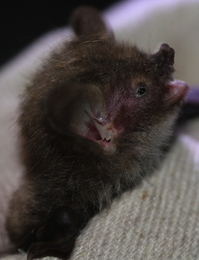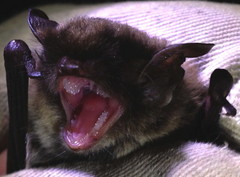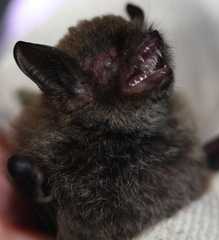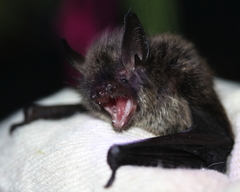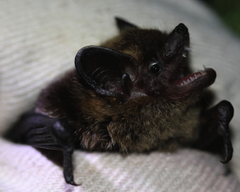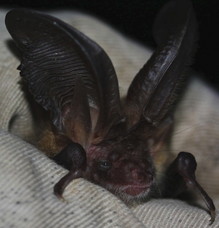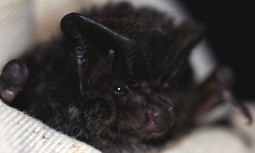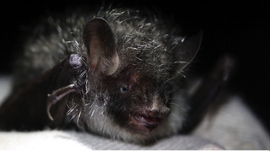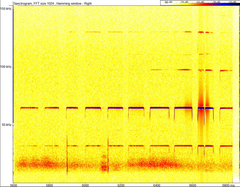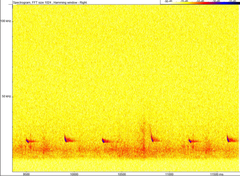Bat species at Horoka Tomamu
These are notes on the bat species discovered during the Horoka Tomamu Forest Bat Survey 2012. There is also a Species checklist (bats) (with links to Wikipedia articles).
Clicking on the pictures will reveal full-sized images.
Ussuri tube-nosed bat (Murina ussuriensis)
Distribution: northeast Asia, including easternmost Russia, Korea and Japan (Hokkaido, Honshu, Shikoku, Kyushu, Tsushima, Yakushima, Iki Island)
Habitat: Forests. Roosts in various structures including bunches of dead leaves and holes in trees. Individuals have also been found roosting in buildings and hibernating in the snow.
Description: The name refers to the small protruding nostrils of the bats. It has golden or greyish brown fur. Ears are short and rounded and there is a large tragus. A small, low-flying bat, it can also hover.
The Ussuri tube-nosed bat was the commonest species in the study by Fukui, D et al. (2009) of bats in southwest Hokkaido, which recorded 193 of the bats captured in 12 different sites. The Ussuri tube-nosed bat was also the species we caught most frequently in Horoka Tomamu. We captured and released 29 of them during the bat survey in 2012: 15 female and 14 male. Its predators include the Japanese rat snake (Elaphe climacophora) which has also been found in Horoka Tomamu.
Ikonnikov's bat (Myotis ikkonikovi)
Distribution: Kazakhstan (Altai Mountains), Mongolia, easternmost Russia, northeast China, and Japan (Hokkaido and northern Honshu)
Habitat: Forests. Roosts in holes in trees, under bark and sometimes in buildings.
Description: fur is grey brown to black; similar to the Ussuri whiskered bat, it has an s-shaped vein pattern on its tail membrane. Body length is up to about 5 cm.
Ikonnikov's bat is believed to be widespread in Hokkaido, and at different altitudes. Seven Ikonnikov's bats, four female and three male, were caught in Horoka Tomamu in 2012. Myotis species in general (the 'mouse-eared bats') were vocal participants in the survey — more frequently heard than the quieter Murina species.
Fraternal myotis (Myotis frater)
Distribution: fragmented occurence in central and east Asia — China, Russia (southern Siberia), Korea, and Japan (Hokkaido and Honshu)
Habitat: Forests. Roosts in trees, but in Hokkaido (where it is commoner than Honshu) it also roosts in caves, tunnels and buildings.
Description: brown bat with rounded ears and a tragus about half the size of the ear. Body length is up to about 5 cm.
Fukui, D et al (2009) only found this bat (9 individuals) in one out of 19 locations in southwest Hokkaido. Five fraternal myotis, four female and one male, were caught in Horoka Tomamu in 2012.
Ussuri whiskered bat (Myotis gracilis)
Distribution: easternmost Russia, northeast China, and north and east Hokkaido
Habitat: Forests. Little is known about their roosts or hibernation sites.
Description: similar to Ikonnikov's bat, this has a straight line vein pattern on its tail membrane. Body length is up to about 5 cm.
Conservation status: endangered according to the Red List (Mammals) of the Ministry of the Environment (2007), redesignated as vulnerable in the 2012 version. The species is not listed by IUCN.
Horoka Tomamu is apparently right on the western edge of its Hokkaido distribution area. (The Ussuri whiskered bat was not reported by Fukui, D et al (2009) at any of the 19 sites surveyed in southwest Hokkaido.)
Three Ussuri whiskered bats, all male, were caught in Horoka Tomamu in 2012.
Northern bat (Eptesicus nilssoni)
Distribution: Europe and Asia — from Norway to Hokkaido, including much of central Europe and the Baltic countries, and both western and eastern Russia
Habitat: Forages in a variety of habitats, including forests, agricultural and built-up areas. Roosts in tree cavities and buildings. Long distance migrations have been recorded of up to 450 km.
Description: brown bat with short ears and relatively short tragus. Body length of up to 6 cm.
Two northern bats, both female, were caught in Horoka Tomamu in 2012.
Distribution: only found in Japan (Hokkaido, Honshu and Shikoku) and the southern Kuril Islands
Habitat: Forest. Roosts in caves, tunnels and buildings, but also in tree cavities.
Description: easily recognisable because of its disproportionately long ears, this species is known in Japanese as the 'rabbit bat'. It has grey fur. Body length is up to about 5.5 cm.
This species is now known to be a separate species from the similar European brown long-eared bat (Plecotus auritus). Two Japanese long-eared bats, both female, were caught in Horoka Tomamu in 2012.
Distribution: found as far west as Egypt, also in central and southern Asia, and in some places in China and Japan. It has been found in parts of eastern Hokkaido, Tohoku, central Honshu, and Shikoku.
Habitat: Forests. Roosts in caves, tunnels and sometimes rock crevices.
Description: fur is dark brown with paler brown underneath. Large triangular ears with a large tragus. Body length is up to about 6 cm.
One Asian barbastelle was caught in Horoka Tomamu in 2012.
Hilgendorf's tube-nosed bat (Murina hilgendorfi)
Distribution: Kazakhstan, Mongolia, northeast China, easternmost Russia, Korea and Japan (from Hokkaido to Kyushu)
Habitat: Forests. Roosts in foliage, tree branches, nest boxes, buildings, tunnels and caves.
Description: unlike the brown Ussuri tube-nosed bat, this animal has greyish fur with silver-coloured long over hairs. It is low-flying and can hover. The ears are oval and there is a large tragus. Body length is up to about 5.5 cm.
Conservation status: vulnerable according to the 2007 Red List (Mammals) of the Ministry of the Environment (2007), however the species was removed from the 2012 red list.
Only one Hilgendorf's tube-nosed bat was caught in Horoka Tomamu in 2012, however at one low-lying location in the Tomokomai Experimental Forest (Hokkaido University), it was the most frequently caught species (Fukui, D et al. 2009).
Greater horseshoe bat (Rhinolophus ferrumequinum)
Distribution: Europe and Asia — from Portugal in the west, through southern Europe and north Africa, the middle east, Iran and Aghanistan, Nepal, China and Korea to Japan (Hokkaido, Honshu, Shikoku, and Kyushu)
Habitat: Forests. Roosts in caves. According to Fukui et al., (2009) this species is typically also found in buildings, tunnels and drains. It is the commonest cave-roosting bat in Japan.
Description: this species had a distinctive 'nose-leaf' used in echo-location. Its thick fur ranges from grey to brown in colour. Body length is up to about 7.5 cm.
They have been recorded as having a lifespan of up to 30 years in Europe and 23 years in Japan. The bats feed on moths, beetles and other insects. Identified by call, not capture, in 2012 (see sonogram of echolocation calls recorded at Horoka Tomamu, above).
Distribution: northeast Asia — northeast China, Korea, Japan
Habitat: Forests. Forages over a variety of habitats, including agricultural areas and lakes. Roosts in cavities especially in large, old trees.
Description: this is the largest insect-eating bat in Japan, with a body lenth of up to 10 cm. It has thick yellowish brown fur.
Conservation status: red listed in Japan as 'vulnerable' and in China as 'near threatened'. The IUCN also regards it as 'near threatened'.
Now thought to be in decline in many places because of habitat loss. Only one maternity colony of this species has been reported in Hokkaido, near Asahikawa (Dewa and Kosuge, 2001). Its predators include owls and hawks. In Horoka Tomamu, this high-flying forest bat was identified by call, not capture, in 2012 (see sonogram of echolocation calls recorded at Horoka Tomamu, above).
References
Bat Study and Conservation Group of Japan, editors (2011): A Field Guide to the Bats of Japan, Bun-ichi Co. Ltd
Dewa, H. and M. Kosuge. 2001. Faunal survey of bats in Asahikawa area, Hokkaido. Bulletin of the Asahikawa Museum, 7: 31-38.
Ohdachi, Satoshi D. I; Ishibashi, Yasuyuki; Iwasa, Masahiro A.; Saitoh, Takashi (2009): The Wild Mammals of Japan, Shoukadoh, Kyoto, ISBN 978-4-87974-626-9
The IUCN Red List of Threatened Species, 2012.1, published by the International Union for Conservation of Nature and Natural Resources
Red List (Mammals) of the Ministry of the Environment (2007) (in Japanese)
Red List (Mammals)of the Ministry of the Environment (2012) (in Japanese)
Simon Holledge, 30 October 2012

